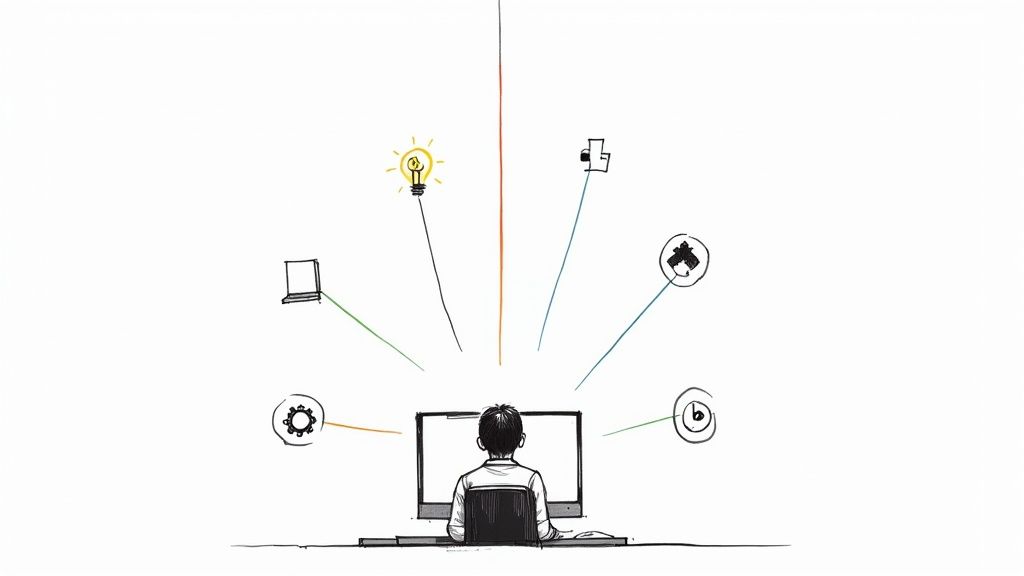
What is Personalized Learning? Discover Its Impact on Education
So, what is personalized learning in simple terms? It’s an educational approach that ditches the one-size-fits-all model. Instead of forcing everyone through the exact same curriculum at the same pace, it adjusts to each individual's unique needs, strengths, and interests.
Think of it like having a personal trainer for your mind, one who designs a custom learning plan just for you.
Understanding the Core of Personalized Learning
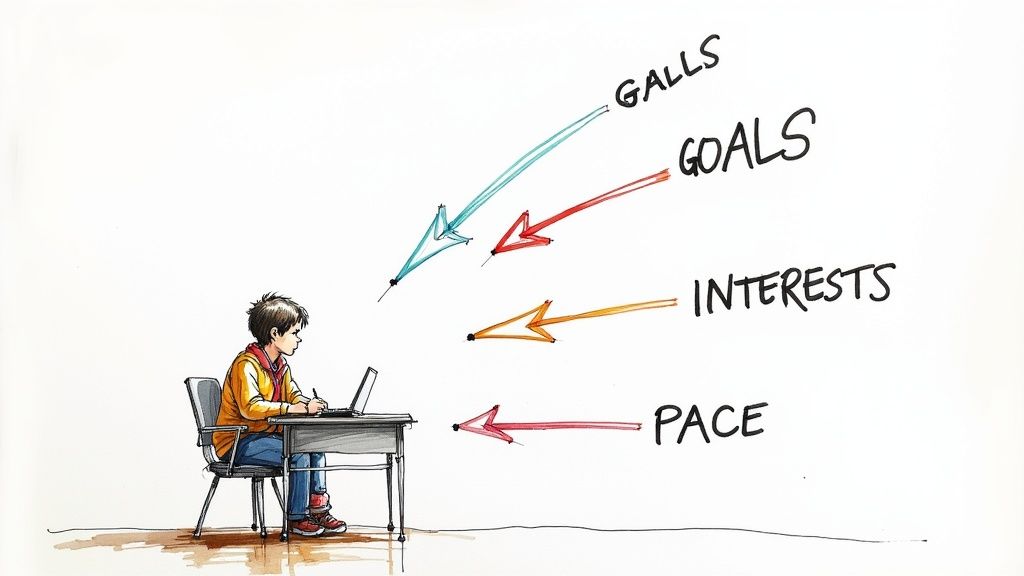
Personalized learning is a major shift away from the traditional classroom where a teacher delivers one lesson to dozens of students. It puts the learner squarely in the driver's seat. The whole point is to make learning more engaging, relevant, and effective by tailoring the what, when, where, and how of learning to each person.
This isn’t just a small tweak; it’s a fundamental change in educational philosophy. It’s built on the simple truth that people learn in different ways and at different speeds. Some might blitz through a concept and be ready for a bigger challenge, while others need more time and support to really get it. Personalized learning creates the flexible space needed to accommodate everyone.
A Departure from Tradition
To truly grasp the difference, let’s look at how personalized learning flips the old model on its head.
The table below breaks down the core differences between the old-school approach and a personalized one. It highlights the move from a rigid, content-focused system to a flexible, learner-centric experience.
Traditional vs. Personalized Learning at a Glance
Seeing them side-by-side makes the philosophical shift crystal clear. It's about empowering the individual, not just managing a group.
In a conventional setting, the curriculum is the constant, and whether a student understands it is the variable. Personalized learning reverses that dynamic.
The core idea is simple: The student’s mastery of a subject becomes the constant, while the time and methods used to achieve it become the variables. This ensures every learner builds a solid foundation before moving on.
This approach, especially at a large scale, is really only possible because of technology. Platforms driven by AI and interactive tools can analyze a learner's performance in real time, pinpointing strengths and weaknesses. From there, the system can dynamically adjust the learning path—offering extra practice, more advanced topics, or even just a different content format to better suit that person. That continuous feedback loop is what makes true personalization a reality for entire companies or school districts.
The growing belief in this model is backed by some serious numbers. The personalized learning market was valued at around $15 billion as of early 2025 and is projected to grow at a compound annual growth rate (CAGR) of about 12% from 2025 to 2033. You can dig into the specifics by checking out the full research on personalized learning growth.
This level of investment shows that tailoring education isn't just a niche idea anymore. It's becoming a key strategy for getting better results in both classrooms and corporate training.
The Real-World Payoffs of Personalized Learning
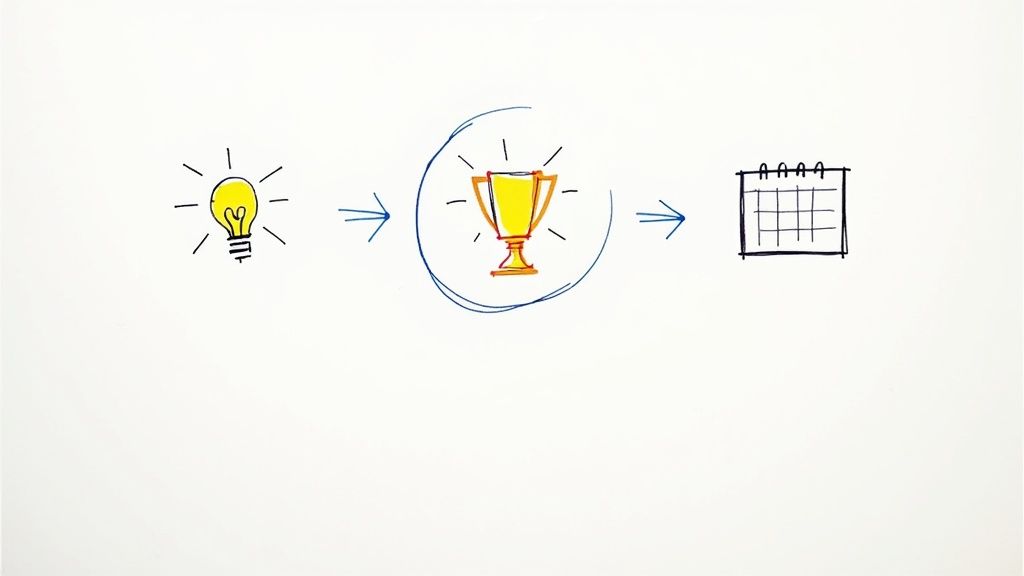
The momentum behind personalized learning isn't just hype; it's driven by a simple fact: it gets results. When we move away from a rigid, one-size-fits-all curriculum, the benefits are tangible and backed by some pretty compelling evidence. Education that adapts to the individual does a lot more than just boost grades—it creates a fundamentally more positive and effective learning environment for everyone.
At its heart, personalization gives students a real sense of ownership. They're no longer just passively sitting through a lecture but are now active drivers of their own education. That shift alone has a massive impact on motivation, turning learning from a chore into a challenge they feel ready to tackle.
Boosting Academic Performance
One of the clearest wins is a measurable jump in academic outcomes. Think about it: when learners can move at their own pace—getting extra support where they’re stuck and jumping ahead where they excel—they build a much more solid foundation of knowledge. This approach helps prevent those classic learning gaps that so often appear in a traditional classroom setting.
The data tells a powerful story here. Research shows that students in personalized learning environments score about 30% higher on standardized tests compared to their peers in traditional classrooms. The difference in motivation is just as stark, with 75% of students reporting they feel engaged, versus a mere 30% in conventional settings.
Enhancing Engagement and Retention
But higher test scores are only part of the picture. A personalized approach also builds deeper engagement and much better long-term retention. By linking new ideas to a learner's existing interests and knowledge, the material suddenly becomes more relevant, and therefore, more memorable.
This is where the idea of personalized learning pathways really shines. Instead of marching down a single, linear track, learners can explore topics in an order that clicks for them, forging connections that actually stick. You can dive deeper into building these with our guide on creating effective personalized learning pathways.
When learners feel seen and understood, their confidence grows. They are more willing to take risks, ask questions, and tackle difficult problems because the experience is designed to support them, not just evaluate them.
This creates an incredible positive feedback loop. More engagement leads to better understanding, which in turn builds confidence and sparks a genuine desire to learn more. The focus shifts from just getting through assignments to truly mastering the skills.
- Increased Ownership: Students take an active role in steering their own educational journey.
- Reduced Frustration: The freedom to learn at one's own pace minimizes the feeling of being left behind or held back.
- Deeper Curiosity: Content that’s actually relevant and customized sparks a real interest in the subject.
Ultimately, these benefits combine to create a more resilient, motivated, and capable learner. The goal isn't just to pass the next test but to build skills and a love for learning that will last a lifetime.
How Personalized Learning Actually Works
Personalized learning isn't some rigid, one-size-fits-all method. It’s better to think of it as a flexible framework, where several key components work together to create a truly individual educational experience. It’s less like a traditional classroom lecture and more like a high-tech, responsive guide built around a single person—the learner.
This system is constantly learning about you in order to find the most effective path for you.
The Building Blocks of Personalization
At its core, personalization is all about understanding the individual. This starts with creating a Learner Profile, which is a lot like the detailed user profile a streaming service builds on you. It goes way beyond just test scores.
A solid Learner Profile captures a person's strengths, weaknesses, preferred learning styles, genuine interests, and past academic performance. This rich, data-driven portrait is the jumping-off point for every decision the system makes.
With that profile in hand, the system then maps out a Personal Learning Path. Imagine a "choose your own adventure" book, but for education. Based on the Learner Profile, this path offers different routes, resources, and activities. For instance, a student who zips through a math concept might get a set of advanced problems, while another learner could be guided to a quick video tutorial for extra support before they move on.
This whole journey is deeply connected to the principles of adaptive learning, where technology adjusts the content and difficulty in real time based on how the user is doing. You can get the full rundown in our guide on what is adaptive learning to see exactly how these smart systems work.
This infographic breaks down the essential parts that make these custom educational experiences tick.
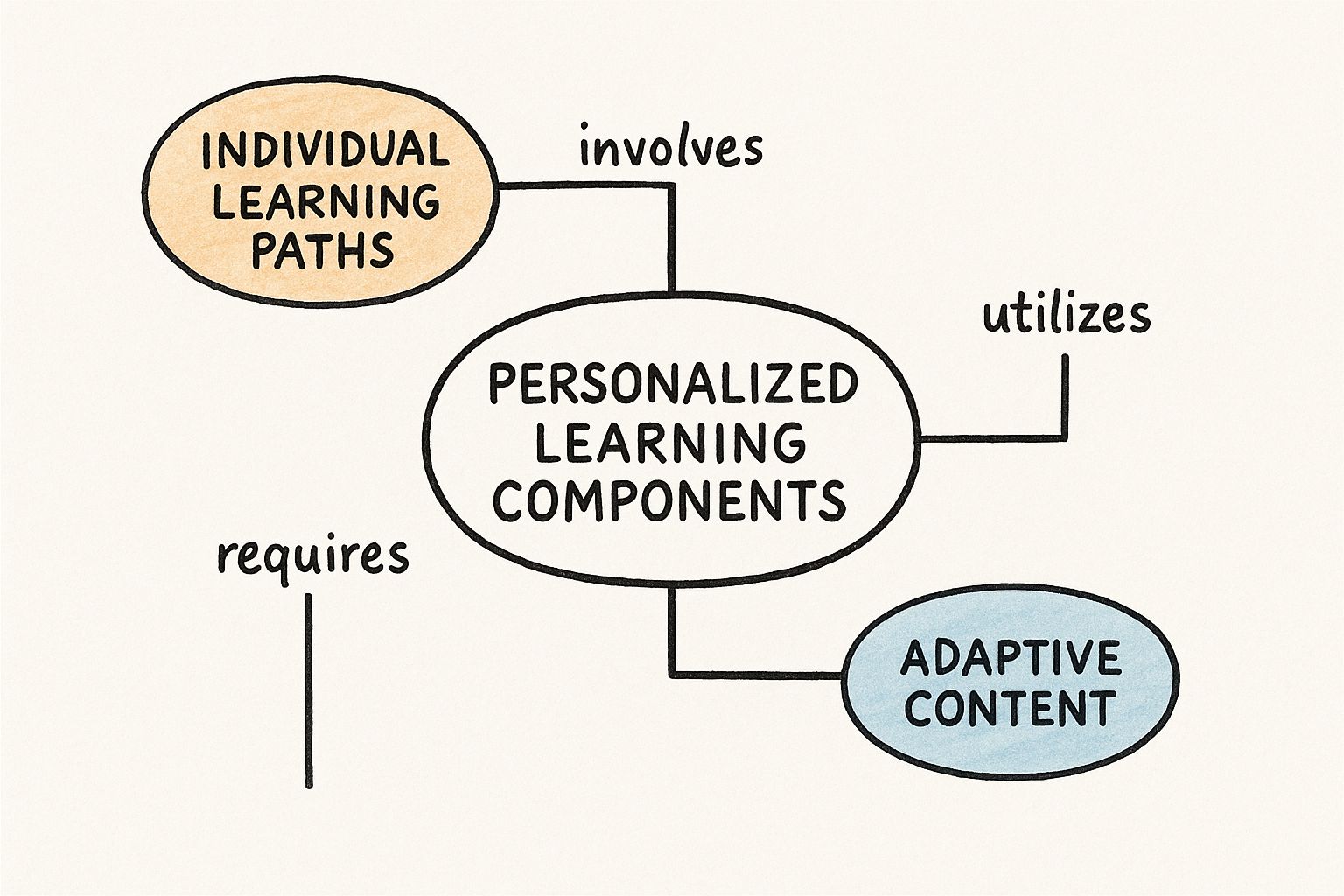
As the map shows, individual paths, adaptive content, and constant progress monitoring are all interconnected, holding up the entire personalized learning structure.
Advancing Based on Mastery, Not Time
Another game-changing idea is Competency-Based Progression. This concept completely flips the script on how learners move forward.
Instead of progressing based on time spent in a course, learners advance only after they have demonstrated true mastery of a concept or skill.
Think of it like earning belts in martial arts. You don't get a black belt just for showing up to class for a year; you get it by proving you've mastered specific forms and techniques. This model makes sure no one gets pushed ahead with critical knowledge gaps, which builds a much stronger and more reliable foundation of skills.
Finally, all these pieces operate within a Flexible Learning Environment. This isn't just about comfy chairs and good lighting. It refers to an entire ecosystem—physical or digital—that provides the tools, resources, and support needed for these individual journeys. This could include things like:
- Digital Resource Libraries: On-demand access to videos, articles, and interactive simulations.
- Collaborative Spaces: Areas designed for group projects and peer-to-peer help.
- Quiet Zones: Spots for focused, individual work without distractions.
By combining detailed Learner Profiles, custom-built paths, mastery-based advancement, and flexible environments, personalized learning creates a powerful and effective educational model that truly puts the individual first. It’s a system designed not just to throw information at people, but to foster genuine, lasting understanding.
The Technology Powering Personalized Education
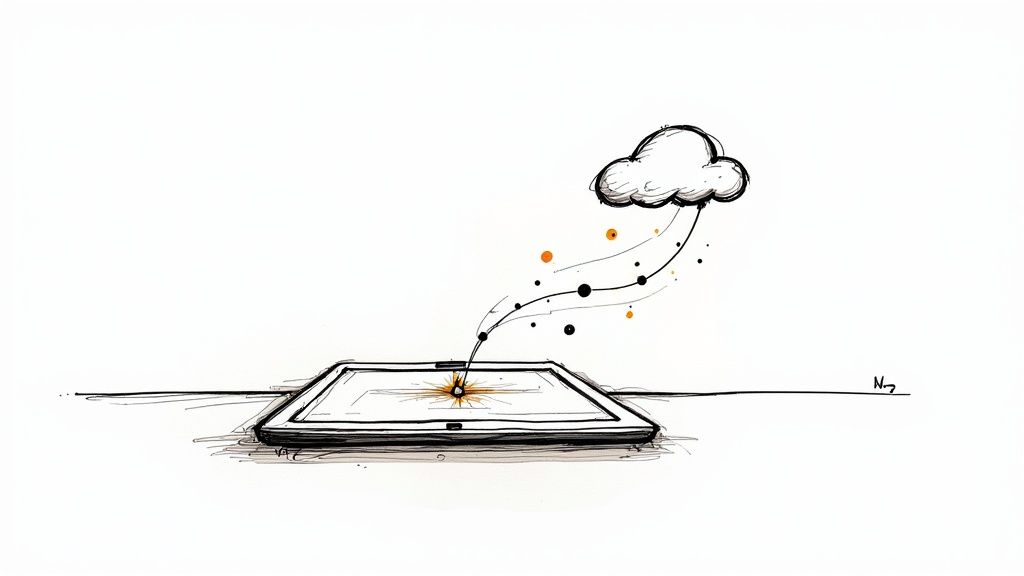
Modern personalized learning isn’t just a nice idea; it’s powered by some seriously smart technology. At the heart of it all is Artificial Intelligence (AI). If personalization is the destination, AI is the engine getting us there, turning a one-size-fits-all lesson into something that feels alive and responsive to each individual.
Think of an AI platform as the mission control for a learning journey. It’s constantly collecting and crunching data on how a student is doing—not just their test scores, but how they engage with the material, where they get stuck, and which concepts they master quickly.
This nonstop flow of information lets the system make smart, automatic adjustments. It might tweak the difficulty of the next question, serve up a helpful article or video, or even build a brand new, adaptive learning pathway on the fly. It's what allows us to finally move away from the old-school lecture model and toward a true one-on-one educational conversation, even at scale.
Key Technologies in Action
So, how does this actually work? It really boils down to two key types of technology: adaptive learning software and intelligent tutoring systems. Both lean on AI to craft an experience that’s unique to every user.
Adaptive Learning Software: This is the big-picture category. These are platforms designed to change how content is presented based on a student's real-time performance. For instance, if a learner bombs a quiz on a specific topic, the software can automatically queue up a foundational video to watch before they can try again.
Intelligent Tutoring Systems (ITS): Think of these as the next level of adaptive software. An ITS is like having a virtual one-on-one tutor. It uses more advanced AI to deliver customized instruction and immediate feedback. It can figure out why a student is misunderstanding something and guide them through tricky problems with smart, Socratic-style questions, pushing for critical thinking instead of just memorization.
At their core, these technologies automate the feedback loop between learning and assessment. They shrink the time between a student's action and the instructional response, making learning a continuous, interactive cycle instead of a series of disconnected events.
The Accelerating Adoption of AI
The results speak for themselves, and these tools are going mainstream—fast. The wider EdTech market, which is heavily driven by AI-powered tools, is on track to hit $404 billion by 2025. What’s more, a recent survey revealed that 60% of educators are already using AI in their teaching methods. If you're curious about this explosive growth, you can dig into the latest AI in education statistics.
This isn't just a trend. Technology is shifting from being a simple add-on to becoming the core infrastructure for a smarter, more engaging, and genuinely personal approach to learning. Tools like interactive video platforms are leading the charge, giving educators and corporate trainers a practical way to bring these powerful concepts to life.
Putting Personalized Learning into Practice
It's one thing to talk about the theories behind personalized learning, but what does it actually look like when you put it into practice? The great news is you don’t need some ridiculously complex, custom-built system to get started. In fact, one of the most powerful and accessible tools for the job is interactive video.
Platforms like Mindstamp give educators and corporate trainers the ability to turn standard, passive video content into active, two-way conversations. This is where the rubber meets the road, bridging the gap between abstract theory and real-world application. It makes the core ideas of personalized learning something anyone can achieve.
Creating Adaptive Journeys with Interactive Video
The real magic of interactive video is its power to create custom learning paths. This is where the old "choose your own adventure" concept truly comes to life in an educational setting, and the key feature that makes it all possible is branching logic.
Imagine you’re rolling out a corporate training video for new software. A question pops up early on: "Have you used our previous software version?" Simple enough. But based on the viewer's "yes" or "no" click, the video can automatically jump to entirely different segments. A "yes" might trigger a short clip highlighting only the new features, while a "no" could branch to a more foundational overview of the basics.
This simple interaction ensures every single viewer gets the information that's most relevant to them. It respects their time and what they already know, offering a practical, immediate way to tailor the experience without adding complexity for the learner.
This screenshot shows exactly how clickable elements inside a video can give viewers different paths to explore the content.
By clicking on a specific topic, the viewer is instantly taken to the content that matters most to them, letting them skip everything else.
Turning Viewers into Active Participants
Beyond just branching, interactive tools are fantastic for turning passive viewing into an active learning process. This is a game-changer for boosting both engagement and, more importantly, knowledge retention. Instead of just sitting back and listening, learners have to think and participate directly with the video content.
You can easily embed elements like:
- Clickable Hotspots: Think of these as clickable zones you can place over anything in your video. A learner could click a hotspot on a piece of equipment to pull up a definition, a link to a spec sheet, or a close-up image. It lets them explore topics at their own speed.
- Embedded Questions: You can pause the video at key moments to insert multiple-choice, open-ended, or even poll questions. This works as a quick knowledge check, making sure learners are actually grasping the material before they move on.
These features hand the controls over to the learner. If a concept is a bit fuzzy, they can click a hotspot for more detail. If they feel like they've got it down, they can answer a question to prove their mastery and keep going. To see more creative ways this can be done, check out these powerful ways to personalize your video content.
Ultimately, using interactive video is a foundational first step in putting the principles of personalized learning into action. It gives you the tools to build a responsive, data-driven, and genuinely engaging learning environment that adapts to the needs of each person.
Your Next Steps in Personalized Learning
We've covered a lot of ground, moving past the buzzwords to see what personalized learning really looks like in practice. At its heart, it’s a simple but powerful idea: building the educational journey around the student, not the other way around. This student-first model is proven to boost both engagement and achievement.
The different approaches we've discussed—from learner profiles to competency-based tracks—give you a blueprint. And technology, especially tools like interactive video, provides the building blocks to make it all happen.
The key takeaway here is about empowerment. Whether you're an educator, a corporate trainer, or just a dedicated lifelong learner, the tools to start creating more adaptive and effective learning experiences are right at your fingertips.
The future of learning isn't about replacing human connection but enhancing it. Technology should handle the data-driven adjustments, freeing up instructors to focus on what matters most: mentoring, inspiring, and providing one-on-one guidance.
Start Your Journey Today
The best way forward is to start embracing tools that turn learning into a two-way street. Here’s how you can get going right now:
- Explore Interactive Tools: Don't just watch a video, interact with it. Platforms like Mindstamp let you drop in questions and build branching paths, giving you an immediate taste of what personalization feels like.
- Collect Feedback: Use simple in-video questions to check for understanding. You’ll quickly see what your audience gets and where they might need a little more help.
- Think in Pathways: Start sketching out how different people might move through your content. Look for opportunities to create unique routes based on their specific needs or job roles.
Taking these small steps makes learning more responsive, more accessible, and ultimately, more powerful for every single person.
Frequently Asked Questions
Even as the big picture of what is personalized learning comes into focus, a few common questions always seem to pop up. Let's tackle them head-on to clear up any lingering doubts about how this all works in the real world.
Is Personalized Learning Only For K-12 Students?
Not a chance. While personalized learning first made waves in K-12 schools, its principles are just as powerful in higher education and corporate training.
Many businesses are now using it to completely rethink employee onboarding, compliance training, and professional development. This approach tailors the material to an employee's existing knowledge and specific job role, which makes corporate training massively more efficient.
Does Personalized Learning Replace Teachers?
Absolutely not. The real goal is to empower the teacher, not make them obsolete. Technology takes over the routine, time-consuming tasks like collecting data and grading simple quizzes.
This frees up educators to do what they do best: focus on the high-value, human-to-human interactions.
It effectively shifts the teacher's role from a "sage on the stage" to a "guide on the side." They suddenly have more time for one-on-one mentoring, leading group projects, and addressing the specific student needs that the technology helps bring to light.
What Is the Difference Between Personalization and Differentiation?
It's a great question, as the two terms are often used interchangeably, but they describe two very different strategies.
- Differentiation: Think of this as a teacher-led approach. The instructor takes a single lesson and makes small adjustments for different groups of students based on their needs. The core lesson, however, is the same for everyone.
- Personalization: This is a truly learner-driven experience. The entire learning path—including the pace, content, and goals—is uniquely designed for each individual, usually with the help of technology.
At its core, personalization is a much deeper, more detailed version of differentiation. It doesn't just tweak the lesson; it creates a one-of-a-kind educational journey for every single person.
Ready to turn your standard video content into a dynamic, personalized learning experience? With Mindstamp, you can easily build adaptive viewing paths, add questions right inside your video, and see real-time data to know what's working. Start creating more engaging and effective videos today at mindstamp.com.
Get Started Now
Mindstamp is easy to use, incredibly capable, and supported by an amazing team. Join us!



Try Mindstamp Free










